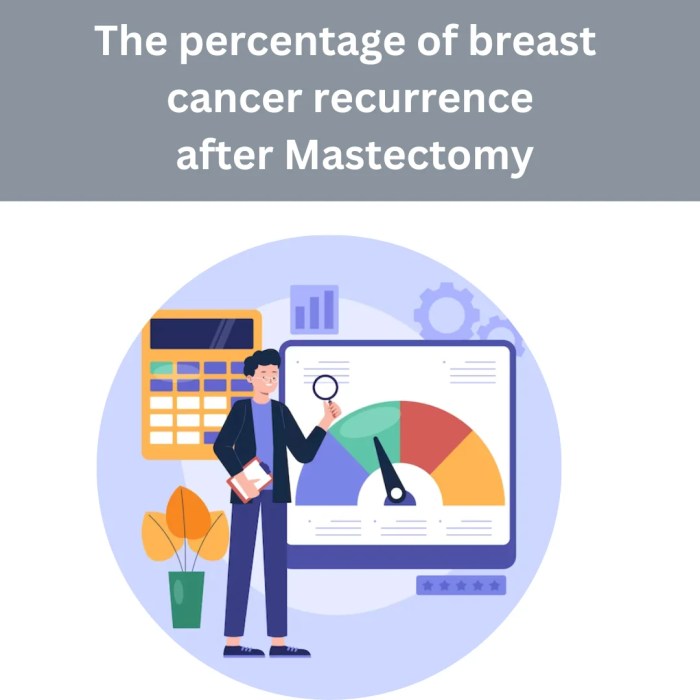Triple negative breast cancer recurrence after mastectomy is a complex and challenging medical issue, demanding careful consideration of the biological mechanisms driving recurrence, clinical manifestations, treatment strategies, patient outcomes, and the essential support systems for affected individuals. This detailed exploration delves into the intricacies of this specific form of breast cancer recurrence, highlighting the unique characteristics and implications for those facing this diagnosis.
Understanding the various factors influencing recurrence, including risk factors, molecular mechanisms, clinical presentations, and treatment options, is crucial for developing effective strategies to improve patient outcomes. This information is vital for empowering individuals with triple negative breast cancer and their healthcare providers in making informed decisions about their care and future treatment plans.
Introduction to Triple-Negative Breast Cancer Recurrence Post-Mastectomy
Triple-negative breast cancer (TNBC) is a subtype of breast cancer characterized by the absence of estrogen receptors (ER), progesterone receptors (PR), and human epidermal growth factor receptor 2 (HER2). This aggressive form of breast cancer often requires more intensive treatment approaches compared to other breast cancer subtypes. A mastectomy, the surgical removal of the breast, is frequently part of the initial treatment plan for TNBC, aiming to eliminate the tumor and surrounding tissue.TNBC, due to its biological characteristics, has a higher propensity for recurrence compared to other breast cancer types.
Recurrence, in this context, means the cancer returns either at the same site (local recurrence) or in a different part of the body (distant metastasis). Understanding the potential pathways of recurrence is crucial for developing effective surveillance and preventative strategies for patients who have undergone mastectomy.
Definition of Triple-Negative Breast Cancer (TNBC)
Triple-negative breast cancer (TNBC) is defined by the absence of estrogen receptor (ER), progesterone receptor (PR), and human epidermal growth factor receptor 2 (HER2) in the tumor cells. This lack of targeted receptors for hormone therapy and HER2-targeted therapies often leads to a more aggressive treatment approach.
Typical Treatment Protocol for TNBC, Including Mastectomy
The typical treatment protocol for TNBC often includes a combination of surgery, chemotherapy, radiation therapy, and sometimes targeted therapies. Mastectomy, the surgical removal of the breast, is frequently employed to eliminate the primary tumor and surrounding tissue, reducing the risk of further spread. Adjuvant therapies like chemotherapy and radiation aim to eliminate any remaining cancer cells.
Different Ways TNBC Can Recur After Mastectomy
TNBC can recur in various ways after mastectomy. Local recurrence involves the reappearance of cancer cells in the same breast or surrounding tissues. Distant metastasis, on the other hand, signifies the spread of cancer cells to other parts of the body, such as the lungs, bones, or liver. Understanding these different routes of recurrence is vital for appropriate patient monitoring and treatment.
Dealing with triple-negative breast cancer recurrence after a mastectomy can be incredibly tough. It’s a complex situation, and while researching, I stumbled upon an interesting question: what kind of bug bite leaves a bruise? This resource delves into the specifics of different insect bites and their potential for bruising, which, honestly, I found surprisingly helpful in understanding the different ways the body can react to trauma.
Ultimately, the focus remains on the challenges of triple-negative breast cancer recurrence after mastectomy, but this connection to the physical response to injury helped me to better process the situation.
Common Risk Factors Associated with TNBC Recurrence After Mastectomy
Several factors can increase the risk of TNBC recurrence after mastectomy. These include the size and grade of the initial tumor, the presence of lymph node involvement, the patient’s age, and overall health. Other important considerations include the specific treatment approach, and the presence of genetic factors that predispose individuals to the development and recurrence of the disease.
Comparison of Recurrence Rates of TNBC with Other Breast Cancer Subtypes Post-Mastectomy
| Breast Cancer Subtype | Estimated Recurrence Rate (Post-Mastectomy) |
|---|---|
| Triple-Negative Breast Cancer (TNBC) | Approximately 30-40% within 5-10 years. This rate varies depending on specific factors like tumor size, grade, and treatment. |
| ER-Positive Breast Cancer | Generally lower than TNBC, often in the range of 10-20% within 5-10 years. |
| PR-Positive Breast Cancer | Similar recurrence rate to ER-positive breast cancer, usually between 10-20% within 5-10 years. |
| HER2-Positive Breast Cancer | Ranges between 10-20% within 5-10 years. Can vary depending on treatment strategies. |
Note: Recurrence rates are estimates and can vary based on individual patient characteristics and treatment protocols.
Understanding the Biological Mechanisms of Recurrence
Triple-negative breast cancer (TNBC) recurrence after mastectomy is a complex process driven by various intricate biological mechanisms. Understanding these mechanisms is crucial for developing targeted therapies and improving patient outcomes. This exploration delves into the molecular underpinnings of TNBC recurrence, highlighting the genetic and epigenetic alterations, immune evasion strategies, and metastatic processes involved.TNBC’s aggressive nature stems from its unique biological characteristics, particularly its lack of estrogen, progesterone, and HER2 receptors.
This absence of targeted pathways makes TNBC recurrence more challenging to predict and treat, underscoring the need for a deep understanding of the driving forces behind its relapse.
Molecular Mechanisms Contributing to Recurrence
TNBC recurrence is not a singular event but a complex cascade of molecular changes. These alterations involve multiple signaling pathways and cellular processes, leading to uncontrolled cell growth, invasion, and metastasis. Genetic mutations can directly disrupt these pathways, while epigenetic modifications can alter gene expression without altering the DNA sequence itself. This interplay of genetic and epigenetic alterations creates a potent environment conducive to tumor growth and spread.
Genetic Alterations Driving Recurrence
TNBC exhibits a high degree of genetic heterogeneity, with various mutations contributing to its aggressive behavior. Specific mutations in genes like TP53, PTEN, and ATM have been implicated in TNBC recurrence. These mutations can disrupt critical cellular functions, leading to uncontrolled cell proliferation and decreased apoptosis (programmed cell death), facilitating tumor growth and survival. Further, copy number variations and chromosomal instability can lead to an amplification of oncogenes or a loss of tumor suppressor genes, further fueling the cancer’s progression.
Epigenetic Modifications and TNBC Recurrence
Epigenetic modifications, such as DNA methylation and histone modifications, play a significant role in regulating gene expression without altering the underlying DNA sequence. Aberrant epigenetic modifications can silence tumor suppressor genes or activate oncogenes, contributing to TNBC recurrence. Changes in the epigenome can lead to a persistent inflammatory state, which is a critical factor in tumor development and progression.
This intricate interplay of genetic and epigenetic changes significantly impacts TNBC recurrence.
Immune Evasion and Metastasis in TNBC Recurrence
Tumor cells can evade the immune system’s surveillance mechanisms, allowing them to proliferate and spread. This immune evasion is often achieved through the expression of immune checkpoint molecules or by suppressing the activity of immune cells like T cells. This creates a conducive environment for metastasis, where cancer cells detach from the primary tumor, invade surrounding tissues, and establish secondary tumors in distant organs.
Dealing with triple-negative breast cancer recurrence after a mastectomy can be incredibly tough. Finding the right support system and coping mechanisms is crucial. For instance, navigating the different antidepressant options like Cymbalta vs Lexapro for depression can be overwhelming, and knowing which is better for you personally is important. This resource can help you explore the pros and cons of each medication.
Ultimately, though, remembering that you’re not alone in this journey and focusing on the support available to you is key to managing the emotional aspects of recurrence.
The metastatic process is a complex multistep process involving various signaling pathways and cellular interactions. The specific molecular mechanisms involved in immune evasion and metastasis are still under intense investigation.
Key Biological Pathways Involved in TNBC Recurrence
| Pathway | Key Proteins/Signaling Molecules | Role in Recurrence |
|---|---|---|
| PI3K/Akt/mTOR | PI3K, Akt, mTOR | Promotes cell growth, survival, and proliferation. |
| MAPK/ERK | MAPK, ERK | Regulates cell growth, differentiation, and survival. |
| Wnt/β-catenin | β-catenin | Plays a role in cell proliferation and survival. |
| VEGF/Angiogenesis | VEGF | Stimulates blood vessel formation (angiogenesis), supporting tumor growth. |
| NF-κB | NF-κB | Regulates inflammation, cell survival, and proliferation. |
The table above highlights some key pathways frequently implicated in TNBC recurrence. These pathways are often dysregulated in TNBC, contributing to the development of the disease and its recurrence after mastectomy.
Key Proteins and Signaling Molecules Implicated in TNBC Recurrence
Specific proteins and signaling molecules play critical roles in the complex mechanisms of TNBC recurrence. Examples include growth factors, cytokines, and cell adhesion molecules. The dysregulation of these molecules often drives the progression of TNBC. Understanding their specific functions and interactions is crucial for developing targeted therapies to address TNBC recurrence after mastectomy.
Clinical Manifestations and Diagnosis of Recurrence
Navigating the complexities of triple-negative breast cancer (TNBC) recurrence after mastectomy requires a deep understanding of its potential manifestations and the precise diagnostic methods used to detect it. Early detection is crucial for timely intervention and improved treatment outcomes. This phase focuses on the common clinical presentations and diagnostic approaches for recurrent TNBC.
Common Clinical Presentations of TNBC Recurrence
Understanding the diverse range of symptoms and signs associated with TNBC recurrence is paramount for early detection. Recurrence can manifest in various ways, often mimicking other medical conditions. Common presentations include:
- A new lump or mass in the breast or chest wall. This can be a hard, painless lump or a softer, tender mass.
- Skin changes, such as dimpling, redness, or peau d’orange (an orange-peel appearance). These changes can be subtle and initially overlooked.
- Nipple discharge, including bloody or serous discharge, which might be present without a palpable mass.
- Pain or tenderness in the breast or chest wall, which can vary in intensity.
- Swelling or enlargement of lymph nodes in the armpit or other areas. Swollen nodes may be painless, but their presence should be investigated.
- Bone pain, which may be a sign of bone metastasis.
Diagnostic Methods for Detecting TNBC Recurrence
Accurate diagnosis of TNBC recurrence hinges on a multi-faceted approach combining various diagnostic tools. The diagnostic journey often begins with a thorough patient history and physical examination. Additional tests are crucial for confirmation and staging.
- Physical Examination: A meticulous physical examination, including palpation of the breast, chest wall, and regional lymph nodes, is essential for identifying any suspicious abnormalities. This initial step can help narrow down potential areas of concern and guide subsequent investigations.
- Imaging Techniques: Imaging plays a pivotal role in detecting subtle changes that may indicate recurrence. Various modalities provide crucial insights into the extent and location of the disease.
Role of Imaging Techniques in Detecting Recurrent TNBC
Imaging techniques are instrumental in visualizing the presence and extent of recurrent TNBC. These techniques provide crucial information for staging and treatment planning. Mammography, ultrasound, and MRI are frequently employed.
- Mammography: While its sensitivity for detecting small, early recurrences might be lower compared to MRI, mammography remains a valuable tool for detecting density changes, masses, or calcifications that might suggest recurrence. Its affordability and widespread availability make it a critical first-line imaging technique.
- Ultrasound: Ultrasound provides detailed anatomical information, aiding in differentiating between solid and cystic lesions. Its real-time capability allows for dynamic assessment, particularly helpful for evaluating suspicious areas detected during physical examination or other imaging studies.
- Magnetic Resonance Imaging (MRI): MRI is considered a highly sensitive modality for detecting recurrent TNBC, especially in dense breast tissue. Its ability to visualize soft tissue structures makes it valuable in assessing subtle changes that might be missed by other imaging techniques. Gadolinium-enhanced MRI is particularly effective in highlighting areas of tumor activity.
Summary Table: Typical Symptoms and Signs of TNBC Recurrence
| Symptom/Sign | Description |
|---|---|
| New breast lump | Palpable mass, possibly hard or soft, painless or tender. |
| Skin changes | Dimpling, redness, peau d’orange, or other alterations in skin texture. |
| Nipple discharge | Bloody, serous, or other abnormal nipple discharge. |
| Pain/tenderness | Discomfort in the breast or chest wall, varying in intensity. |
| Lymph node enlargement | Swollen, possibly painless, lymph nodes in the armpit or other areas. |
| Bone pain | Pain localized to bones, often a sign of distant metastasis. |
Table: Imaging Modalities Used in Detecting Recurrent TNBC
| Imaging Modality | Description | Strengths | Limitations |
|---|---|---|---|
| Mammography | X-ray imaging of the breast | Cost-effective, widely available | Lower sensitivity for small, early recurrences in dense breast tissue |
| Ultrasound | High-frequency sound waves to create images | Real-time imaging, differentiates solid/cystic lesions, useful for guiding biopsies | Limited penetration in dense breast tissue |
| MRI | Magnetic fields and radio waves to produce detailed images | High sensitivity, especially in dense breast tissue, visualizes soft tissues, assesses tumor activity | Higher cost, potential for false positives, use of contrast agents |
Treatment Strategies for Recurrent TNBC Post-Mastectomy
Facing a recurrence of triple-negative breast cancer (TNBC) after a mastectomy can be incredibly challenging. The aggressive nature of TNBC, coupled with the need for personalized treatment approaches, necessitates a deep understanding of the available options. This section delves into the various treatment strategies, highlighting the crucial role of tailoring therapy to the specific characteristics of the recurrence.Recurrent TNBC, especially after mastectomy, demands a multifaceted approach.
Treatment decisions are not solely based on the initial diagnosis; factors like the site of recurrence, tumor characteristics, and patient’s overall health are paramount. A thorough evaluation, encompassing imaging studies, pathology reports, and biomarker analysis, is crucial for determining the optimal course of action.
Chemotherapy Regimens for Recurrent TNBC
Different chemotherapy regimens are employed based on the specific genetic and molecular characteristics of the recurrent tumor and the patient’s overall health. The selection process necessitates a careful balancing act between potential benefits and side effects. Several chemotherapy drugs, such as paclitaxel, carboplatin, and gemcitabine, may be used in various combinations to combat the cancer cells. The choice of regimen often depends on previous treatments and potential drug interactions.
Targeted Therapies in Recurrent TNBC
Targeted therapies, designed to specifically attack cancer cells, are becoming increasingly important in treating recurrent TNBC. These therapies exploit specific molecular pathways that drive tumor growth and spread. Examples include drugs targeting HER2 or other growth factors. The efficacy of targeted therapies varies significantly depending on the specific genetic profile of the recurrent tumor.
Hormonal Therapies in Recurrent TNBC, Triple negative breast cancer recurrence after mastectomy
Hormonal therapies are not typically a primary treatment option for TNBC, as it’s not hormone-receptor positive. However, in rare instances where hormonal influences are identified as contributing factors to the recurrence, targeted hormonal therapies may be considered. Such instances often involve investigating specific molecular pathways linked to the recurrence.
Surgical Interventions
Surgical interventions, like localized excision or additional mastectomies, may be necessary in cases of localized recurrence. These interventions aim to remove the recurrent tumor and surrounding tissue. Factors like the extent and location of the recurrence will determine the appropriateness and scope of surgical intervention.
Radiation Therapy for Recurrent TNBC
Radiation therapy may be used to treat localized recurrent TNBC, particularly if the recurrence is in the area previously treated. It aims to reduce the size of the tumor or destroy any remaining cancer cells. The dosage and frequency of radiation are tailored to the individual patient’s needs and the specific characteristics of the recurrence.
Table of Treatment Options for Recurrent TNBC
| Treatment Type | Description |
|---|---|
| Chemotherapy | Utilizes drugs to kill cancer cells. Regimens vary based on tumor characteristics and patient tolerance. |
| Targeted Therapies | Specifically targets molecular pathways driving tumor growth. Examples include HER2-targeted therapies. |
| Hormonal Therapies | Rarely used in TNBC due to its hormone-independent nature. May be considered if specific hormonal influences are identified. |
| Surgical Interventions | Localized excision or additional mastectomies to remove recurrent tumor and surrounding tissue. |
| Radiation Therapy | Used for localized recurrences to reduce tumor size or destroy remaining cancer cells. |
Patient Outcomes and Prognosis

Navigating the path of recurrent triple-negative breast cancer (TNBC) after mastectomy is challenging, demanding a nuanced understanding of influencing factors and potential outcomes. Patients face a complex interplay of biological mechanisms, treatment choices, and personal circumstances, all contributing to the variability in prognosis and long-term well-being. This section delves into the key factors shaping patient outcomes and the available data regarding overall survival.
Factors Influencing Patient Outcomes
Several factors significantly impact patient outcomes in recurrent TNBC following mastectomy. Tumor characteristics, such as the presence of specific genetic mutations or the degree of tumor aggressiveness, play a crucial role. The site and extent of recurrence, along with the patient’s overall health status, including pre-existing conditions, significantly influence treatment options and the likelihood of successful outcomes. Furthermore, patient adherence to prescribed treatment regimens and the quality of supportive care significantly impact their experience and long-term prognosis.
Impact of Recurrence on Overall Survival Rates
Recurrence of TNBC after mastectomy significantly impacts overall survival rates. Unfortunately, the presence of recurrence often signals a more aggressive disease course, potentially leading to a shorter time to death compared to patients without recurrence. This underscores the importance of early detection, aggressive treatment, and close monitoring to improve outcomes and quality of life. Survival rates vary considerably based on factors such as the stage of recurrence, the treatment approach, and the patient’s individual characteristics.
Potential Long-Term Side Effects of Treatment
Treatment for recurrent TNBC after mastectomy can have various long-term side effects. Chemotherapy, a common treatment modality, can lead to fatigue, nausea, hair loss, and other debilitating effects. Radiation therapy may cause skin irritation, fatigue, and long-term discomfort in the treated area. Hormone therapy, if applicable, may induce menopausal symptoms or other hormonal imbalances. The severity of these side effects varies depending on the specific treatment regimen, the patient’s overall health, and their response to therapy.
Carefully managing side effects is crucial for maintaining patient well-being throughout the treatment journey.
Data on Overall Survival Rates
Unfortunately, precise data on overall survival rates for patients with recurrent TNBC after mastectomy are not consistently available in a single, easily accessible format. Data often varies based on the specific characteristics of the recurrence (e.g., site, stage, treatment type), making a single, universally applicable statistic difficult to provide. Clinicians often discuss survival rates in the context of individual patient cases, considering the aforementioned factors.
Research studies are ongoing to further refine our understanding of prognostic indicators and improve outcomes.
Influence of Different Treatment Approaches on Patient Survival
The effectiveness of different treatment approaches in recurrent TNBC after mastectomy varies significantly. While a definitive table illustrating the influence of all possible treatment approaches on survival is not available due to the complexity of variables, the success of treatment depends on several factors, including the patient’s response to therapy, the aggressiveness of the recurrence, and the stage of disease.
A multidisciplinary approach involving oncologists, surgeons, and other healthcare professionals is crucial for optimizing treatment strategies and individualizing care plans.
| Treatment Approach | Potential Impact on Survival | Factors Influencing Impact |
|---|---|---|
| Chemotherapy | May improve survival in some cases | Tumor response, specific chemotherapy regimen, overall patient health |
| Radiation Therapy | May improve local control and potentially survival | Tumor location, dose of radiation, overall patient health |
| Targeted Therapy | May improve survival in certain cases with specific genetic mutations | Presence of specific genetic mutations, tumor characteristics |
| Surgery | May improve local control, but may not always be feasible or appropriate | Tumor location, extent of recurrence, overall patient health |
| Hormone Therapy | May be effective if the recurrence is hormone-receptor positive | Hormone receptor status of the recurrence, overall patient health |
Support and Resources for Patients with Recurrent TNBC Post-Mastectomy
Navigating a recurrence of triple-negative breast cancer (TNBC) after mastectomy is a challenging journey. Beyond the medical aspects of treatment, the emotional and psychological toll can be significant. Finding the right support networks and resources can make a profound difference in coping with this difficult situation. This section will explore the various support systems available to patients and highlight the importance of psychosocial support in managing recurrence.
Dealing with triple-negative breast cancer recurrence after a mastectomy can be incredibly challenging. One often overlooked symptom is the sudden onset of diarrhea and weight loss, which can significantly impact a patient’s overall well-being. Understanding these side effects, and how they relate to treatment regimens, is crucial for managing the condition effectively. For more information on the connection between these symptoms and potential causes, check out this helpful resource on diarrhea and weight loss.
Ultimately, it’s essential to stay informed and proactive in managing these symptoms as part of the ongoing journey with triple-negative breast cancer recurrence after mastectomy.
Support Systems Available to Patients
Patients facing TNBC recurrence after mastectomy often benefit from a multifaceted support system. This includes access to medical professionals, support groups, and online communities. These resources can provide crucial emotional and practical assistance, helping patients navigate the complexities of their treatment journey. A supportive network helps patients feel less isolated and more empowered to face the challenges ahead.
Importance of Psychosocial Support
Psychosocial support plays a vital role in managing the emotional and psychological impact of TNBC recurrence. This includes addressing issues like anxiety, fear, depression, and feelings of isolation. Effective psychosocial support can help patients cope with the emotional distress associated with a cancer diagnosis and treatment, fostering a sense of resilience and empowerment. This support can be tailored to individual needs, encompassing various approaches such as counseling, support groups, and relaxation techniques.
Support Groups and Online Communities
Support groups and online communities provide invaluable platforms for patients with recurrent TNBC to connect with others who share similar experiences. These groups offer a safe space for sharing stories, exchanging information, and providing mutual support. Online communities, in particular, can facilitate connections across geographical boundaries, allowing patients to access a broader network of support. Such connections can reduce feelings of isolation and provide a sense of belonging during a challenging time.
Table of Support Organizations and Resources
| Organization/Resource | Description | Accessibility |
|---|---|---|
| American Cancer Society | Provides comprehensive information, support groups, and resources for cancer patients and their families. | Website, helpline, local chapters |
| National Breast Cancer Foundation | Offers information and support for breast cancer patients, including those with TNBC. | Website, helpline |
| The Susan G. Komen Foundation | Provides various resources, including information about treatment options, support groups, and financial assistance. | Website, local chapters |
| Patient advocacy groups specific to TNBC | Offer specialized support and information tailored to TNBC. | Websites, social media groups |
| Online forums and support groups | Allow patients to connect with others facing similar experiences and share their stories. | Various platforms (e.g., Reddit, dedicated cancer forums) |
Accessing Support Resources
Accessing these support resources is relatively straightforward. Many organizations have user-friendly websites, providing detailed information and contact details. For instance, the American Cancer Society website offers comprehensive resources and information about cancer types, treatments, and support services. Local chapters often host support groups and workshops, offering opportunities for in-person interaction. Utilizing online search engines can help locate specific support groups or communities tailored to the needs of patients with recurrent TNBC.
A patient can use online search engines to find support groups or communities specifically for patients with TNBC. The availability of online resources also expands the reach of support systems, connecting patients from various locations.
Future Research Directions: Triple Negative Breast Cancer Recurrence After Mastectomy

Triple-negative breast cancer (TNBC) recurrence after mastectomy remains a significant challenge. While current treatment strategies have improved outcomes, there’s still a pressing need for better understanding of the complex biological mechanisms driving recurrence and for the development of more effective and personalized therapies. Future research should focus on identifying novel biomarkers, exploring innovative treatment approaches, and refining existing protocols to improve patient outcomes.Understanding the intricate pathways and molecular mechanisms behind TNBC recurrence is crucial for developing targeted therapies.
Current research has identified various genetic and epigenetic alterations, but further investigation into the interplay between these factors and the tumor microenvironment is vital.
Identifying Novel Biomarkers for Early Detection
Early detection of TNBC recurrence is paramount for improving patient outcomes. Developing reliable biomarkers that can predict recurrence risk in patients following mastectomy is a critical area for future research. This includes exploring circulating tumor DNA (ctDNA) analysis, circulating tumor cells (CTCs), and specific protein markers in blood or tissue samples. Early detection allows for timely intervention and potentially more effective treatment.
For instance, if a biomarker reliably identifies a higher risk of recurrence, patients can be monitored more closely and preventative measures or therapies can be implemented earlier.
Exploring Innovative Treatment Strategies
Several promising treatment approaches are being investigated for TNBC recurrence. These include targeted therapies, immunotherapy, and novel combinations of existing treatments. Further research is needed to optimize these approaches and personalize them to specific patient characteristics and tumor subtypes. For example, the development of immunotherapies that specifically target immune checkpoints expressed in TNBC could offer a significant improvement in treatment response rates.
Investigating combinations of chemotherapy, targeted therapies, and immunotherapy may yield even better outcomes.
Developing Personalized Treatment Protocols
The heterogeneity of TNBC makes it crucial to develop personalized treatment strategies. Future research should focus on identifying molecular subtypes of TNBC recurrence and tailoring treatment plans accordingly. This could involve genetic profiling of tumor samples to identify specific vulnerabilities that can be targeted with precision therapies. By understanding the unique characteristics of each patient’s tumor, treatment plans can be optimized for better outcomes.
Evaluating the Role of the Tumor Microenvironment
The tumor microenvironment plays a significant role in TNBC progression and recurrence. Future research should investigate the complex interactions between tumor cells and immune cells, stromal cells, and the surrounding tissue in the context of recurrence. A deeper understanding of the mechanisms by which the tumor microenvironment promotes tumor growth and metastasis could lead to the development of novel therapies that target these supportive factors.
This could include exploring therapies that modulate the immune response or target specific components of the tumor microenvironment.
Ongoing Clinical Trials
A comprehensive understanding of ongoing clinical trials related to TNBC recurrence is essential for informing future research directions. These trials can provide valuable insights into the effectiveness of new treatments and potential side effects. Monitoring and analyzing data from ongoing trials will help to identify promising avenues for further research and development.
Future Research Directions Summary
| Research Area | Specific Focus | Potential Impact |
|---|---|---|
| Novel Biomarkers | Identifying reliable markers for early recurrence detection | Improved early intervention and better patient outcomes |
| Innovative Therapies | Optimizing targeted therapies, immunotherapy, and combination approaches | Enhanced treatment efficacy and reduced side effects |
| Personalized Protocols | Tailoring treatment plans based on molecular subtypes of TNBC recurrence | Improved treatment response and reduced treatment-related toxicities |
| Tumor Microenvironment | Investigating interactions between tumor cells and the surrounding tissue | Development of therapies targeting the tumor microenvironment |
| Clinical Trials | Monitoring and analyzing ongoing trials for TNBC recurrence | Identifying promising new approaches for future research |
Final Thoughts
In conclusion, triple negative breast cancer recurrence after mastectomy presents a multifaceted challenge requiring a comprehensive understanding of the biological underpinnings, clinical manifestations, and treatment options. This discussion underscores the importance of personalized treatment plans, robust support systems, and ongoing research to enhance patient outcomes and improve the quality of life for those affected by this disease. The journey is challenging, but hope remains.




